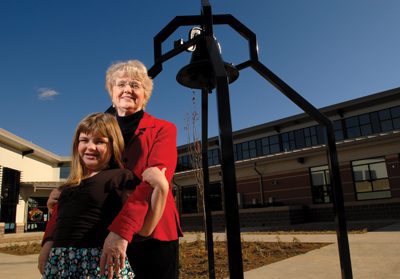by Renee Hunter
Wooster has an elementary school for the first time in 50 years, a school very different from the original – airier, brighter and more fun.
Former students Marilyn (Patterson) Battles and Valerie (Mack) Legrone recently shared their memories of the first school, located on Shaw Bridge Road, with 501 LIFE.
The school’s first buildings were frame barracks brought from Camp Robinson. At some point, a “cutting edge” stone gymnasium was built (near where the firehouse is today) with a heavy wood floor for basketball. The gym was not heated, but neither Marilyn nor Valerie can recall having physical education during the winter.
The gym was the only building with restrooms, and they were often in bad shape – “stopped up or backed up all the time,” Valerie said. An outhouse was in regular use instead.
A schoolyard bell announced the beginning of each day, and only well-behaved sixth-grade boys were allowed the privilege of ringing it. 
After the school closed in 1958, the gym was used as an informal skating rink by area youth. Noreen and Osco Hankins moved the barracks, divided into several buildings, to Highway 285, where they still sit. The bell languished for years in the Hankins yard but today it has a new home in the courtyard at the new school.
The former school had a small cafeteria, where meals were served in three shifts of two grades each.
“We had wonderful meals,” Marilyn said. Peanut butter and banana sandwiches were her favorite, because she didn’t get them at home.
The school had an auditorium where plays were presented. One such play was called “Wedding of the Flowers.”
“I was an iris, and my mother made me a costume out of crepe paper,” Marilyn said. “I felt cute, and no doubt I was.”
Until 1952, the school had students through ninth grade, but by the time Marilyn arrived, it held only first through sixth grade classes.
Each room held two grades. Marie Taylor taught first and second; Mrs. Glenn Glover, third and fourth; and Principal Glenn Glover, fifth and sixth. There were 22 in Marilyn’s first-grade class, and she estimates the school had fewer than 150 students, compared to 425 today. Although Mrs. Taylor was short, just a few inches taller than her students, she had complete control of the classroom, Marilyn recalled.
Before Marilyn’s time, the school bus was unusual. It was a milk truck which picked up the students after delivering the milk. The older boys would help the driver unload the empty milk canisters before he took them to school.
Instead of the table-and-chair groupings of today’s classrooms, students then sat in rows. The desktop of one student was attached to the chair back of the student in front, and each desktop had a groove for a pencil, a hole for a glue pot and a shelf underneath for supplies.
“We didn’t have much,” Marilyn said, “a pencil, maybe some glue and a tablet.”
The age-old “school” smell – chalk dust – will never permeate the new school, which has dry-erase boards. The original school had blackboards, which were actually black and erasers got daily pounding.
At recess, girls played jacks and hopscotch; boys played mumblety peg and marbles.
“I was pretty good at jacks,” Marilyn said.
“We played on that dirty old ground in our dresses,’ Valerie laughed. Girls didn’t wear pants.
The school had a swing set and a merry-go-round, according to Valerie, who remembered being pulled off the latter by “the tail of my dress.” There was a see-saw, too, Marilyn remembers; it consisted of a board balanced on a rock.
Each room in the school was heated by a coiled radiator, which popped when turned on.
“A favorite thing to do was to set a color crayon on it and watch it run down,” said Marilyn. “Mrs. Taylor didn’t take kindly to that; she would tan our hides.”
Spanking was accepted then, and parents didn’t interfere. Faculty controlled the school, and parents, the home. Neither encroached on the other’s territory.
“School was for learning, not for fun,” Marilyn recalls, and she thinks that is a good change. “Who decided learning shouldn’t be fun?”

